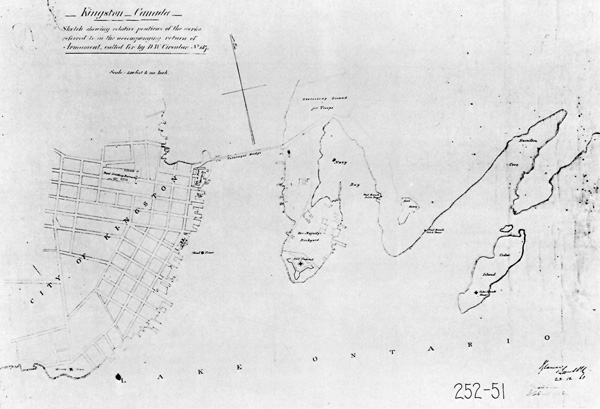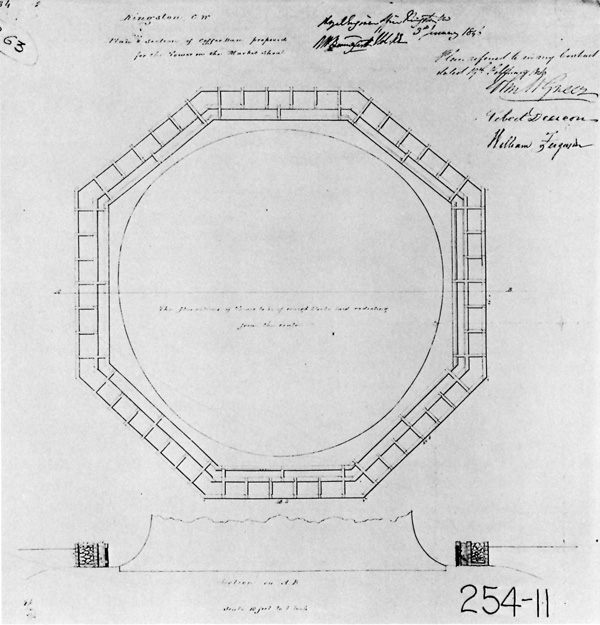Canadian Historic Sites: Occasional Papers in Archaeology and History No. 15
Report of the 1972 Archaeological Excavations of the Market Shoal Tower, Kingston, Ontario
by Donald A. Harris
Historical Background
A detailed historical account by Ivan Sanders of Kingston Harbour,
the Market Shoal tower and their relationships to the St. Lawrence River
accompanies this report; nevertheless, the historical information
presented here will provide the reader with some perspective of the
site.
The history of the Market Shoal tower revolves around the history of
Kingston and its importance as a key strategic position in controlling
the flow of maritime traffic moving from the St. Lawrence to the Great
Lakes. The French early recognized this position for its military
importance and in 1673 constructed Fort Frontenac on the western bank of
the Cataraqui River where it flows into the lake. This position was held
by the French until 1758 when it was captured by a British force led by
Colonel Bradstreet. The British garrisoned Kingston until 1870 when
they, along with all imperial garrisons, were recalled from British
North America (Stanley 1954: 21).
At the termination of the American Revolution a section of the St.
Lawrence River was converted into an international boundary, creating
further problems with which the British had to cope. The hostilities
between Canada and the United States again flared up in 1812,
re-emphasizing the need to fortify Kingston against possible attack. In
1813 the first Fort Henry was erected. The disadvantages of using the
St. Lawrence River as the only means of water communication between
Upper and Lower Canada were also realized and in 1826 Colonel By was
commissioned to construct the Rideau Canal. This canal, designed
primarily for military reasons, needed to be defended and as a result
plans were drawn up in 1829 to erect a system of fortification,
consisting primarily of a strengthened Fort Henry and several outlying
auxiliary fortifications. Work proceeded slowly on Fort Henry and no
progress was really made toward the completion of the auxiliary works.
This situation changed, however, as tensions between the two countries
heightened with the adoption of the "Fifty-Four Forty or Fight" slogan
of the 1844 American presidential election campaign. With the election
of James Polk and the Democratic party, Britain began to prepare for war
with the United States. This preparation did not go unnoticed by the
editors of the Kingston Argus who stated in January, 1846.
It is not for Oregon we shall have to contend, if contend we must.
The blood of the yeomanry of Canada which may be spilled in defence of
their homes will attest their abhorrence of the tyranny of Democracy.
Britain seeks no war with America — Canada seeks none. But let us
imitate Britain and PREPARE FOR WAR as the surest means of securing
PEACE.
The threat was sufficient to incite immediate action on the part of
the master-general of the Ordnance and Board, and plans were quickly
drawn up for the construction of four Martello towers (exclusive of the
two at Fort Henry) for the defence of Kingston Harbour (Fig. 3). The
first of these contracts was let on 30 January 1846 for the construction
of the Murney Tower, and work proceeded so rapidly that the masonry was
ready for testing by 10 June 1846. The contract for the Market Shoal
tower was also let in January of that year, but work on it proceeded at
a much slower rate.

3 Map of Kingston harbour.
(Public Archives of Canada.) (click on image for a PDF version)
|
The construction of the Shoal tower differed from that of the other
towers in that it was built on a shallow shoal in the harbour and was
completely surrounded by water. This posed technical problems that were
not encountered in the construction of the other towers. William Murray
was awarded the contract for its construction and he probably
sub-contracted the initial work to John Greer. It was Greer's job to
construct a coffer-dam (Fig. 4) on the shoal and pump out the water on
the site. He set to work immediately, making good use of the ice, and by
20 March 1846 had completed the dam and had begun to pump out the water.
This chore occupied 15 pumps manned by six or seven men each until the
middle of June when the interior of the coffer-dam was pumped dry. This
dam was 90 ft. in diameter and 7 ft. 6 in. in height, meaning the
displacement of 47,750 cubic ft. of water.

4 Plan and cross-section of coffer-dam as proposed in 1846.
(Public Archives of Canada.)
|
On 15 June 1846, the Oregon Treaty was signed and this project, begun
with the utmost urgency, slowed considerably; it was not until October
of 1847 that the tower's construction was completed. Although the tower
was completed in 1847 it was not armed for another 14 years.
The garrison for the tower was never very large and for the most part
it was placed on a maintenance basis or was looked after by a caretaker.
It was first occupied in 1849 by four guards, and between then and 1854
the number of men never rose above seven. In 1855-56 the tower stood
vacant because of the Crimean War, but as a result of Britain's
involvement in the United States Civil War, the garrison increased to 23
men. These men were all single, whereas before the tower was used for
married quarters. After the crisis in the United States had passed, the
number of men again declined to its previous 1850s level.
The tower was occupied by a British garrison until 1870 when, as
stated above, all imperial troops were withdrawn from British North
America. At that time it was turned over to Lieutenant Colonel Wyly,
Director of Stores of the dominion government, and kept on a maintenance
basis for 10 more years. After this period it was considered obsolete
and was therefore abandoned.
A local informant stated that the tower had been occupied at the turn
of the century and later by a Kingston family, but this story has yet
to he substantiated; however, such an occupation would explain the
recovery of certain artifacts such as toys. After final abandonment, the
tower languished until the mid-20th century when it was re-roofed to
protect it from the elements.
|

